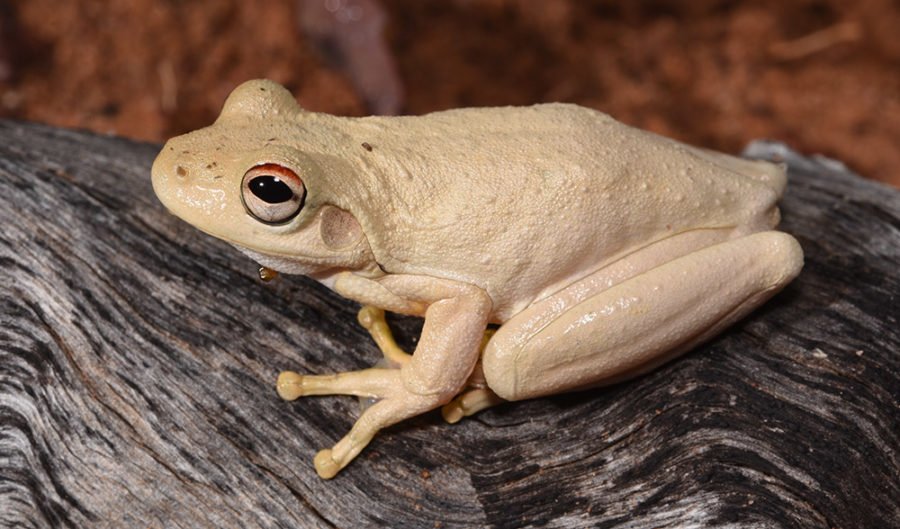Scientists call on public to begin counting Australia’s 241 frog species

“THE FIRST thing you need to know is that each of the 241 species of frog in Australia has a unique call,” Jodi Rowley, the Curator of Amphibian & Reptile Conservation Biology at the Australian Museum, tells Australian Geographic. “You’ll need to get as close as possible to the calling frogs without disturbing them or their habitat,” she adds, explaining how to use the museum’s new app, FrogID.
The idea for the nationwide citizen science project and the app, officially released today, was formulated in the office of the Australian Museum’s Director, Kim McKay, after Jodi had briefly mentioned how useful frog calls were in identifying particular species. “I had no idea that this conversation would lead to such an important project,” Jodi says.
Jodi explains that Australia’s frogs are one of the most endangered groups of animals in the country, with four frog species lost; while others such as the peppered tree frog (Litoria piperata) haven’t been seen since the 1970s and the gorgeously coloured Northern and Southern Corroboree frogs (Pseudophryne corroboree and Pseudophryne pengilleyi), now a rare sight in the highlands of Canberra and New South Wales (NSW) where they were once abundant.
Jodi has played a particularly important role in attempts to rediscover the peppered tree frog, which has seen her trailing the enigmatic species across some of the most rugged terrain in northern NSW, with no luck. But she says her challenge to find this large brown amphibian has allowed her to gather information about other frogs in the area.
“One of the biggest obstacles to ensuring that we don’t lose any more of Australia’s frogs is our lack of knowledge. We still don’t know that much about most species. Australia is a huge country and there are many areas where we don’t really know what frog species occur – never mind how they are doing,” Jodi says.
Ultimately, Jodi wants to turn your smart phone into a tool to collect scientific information on the frogs of Australia. By recording just 20 seconds of the cacophony our noisy frogs, the app is able to narrow down the species based upon the time of year and the user’s location, which will then be confirmed by one of the Museum’s experts.
The call of the Gracefull tree frog found along the coast near Cooktown in QLD, south to Gosford in NSW.
Tips and tricks
Getting down and dirty in your local creek — IPhone in hand— to record a notoriously elusive amphibian will require you to be reasonably cunning.
“Be really still, turn off your torch and wait for the frog or frogs to start calling again. Depending on the species, they might be shy and take a few minutes to call again. Or they might be so keen to breed that they will start up again immediately,” Jodi advises.
The call of the red-crowned toadlet found only in the Sydney Basin in NSW but has declined in the area.
“If you can, point the phone to the nearest calling frog so you can get a clear recording of that species. If you’re keen to improve the quality of the call, there are plug-in microphones that you can get to improve the call recording.”
Jodi also suggests getting to know the locals.
“Most common frog species are relatively easy to tell apart, but there are some tricky frog species,” she says. “It won’t take long for people to become familiar with all their local frog species, because app users will know when they’ve matched a frog species correctly.”
The call off the Striped marsh frog found along the entire coast of NSW, all of coastal VIC, coastal QLD.
Australia’s frogs need your help
“By harnessing everyone in Australia to record frogs across the continent, we’ll be able to get, for the first time, a fine-scale picture of where frog species are, and monitor them over time,” Jodi says. “We’ll be able to discover frog ‘hotspots’ —where frogs are doing well and areas where they’re not.”
The call of the Red tree frog found throughout all of QLD, the NT, the northern half of WA, most of NSW and northern SA.
The frog count is a chance for participants to help scientists understand the impact of climate change, disease, habitat loss — even those pesky cane toads— on our native frog populations. But Jodi’s also hopeful.
“Maybe we’ll discover a new species!”
Donwload the app here.
READ MORE:
- The frogs of Australia: illustrated.
- Time is running out for these seven frog species.
- This is how a frogs tongue works.
- The smal lfeet and hands of Australia’s frogs.

